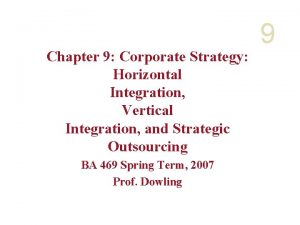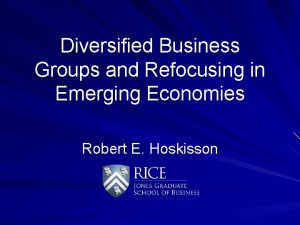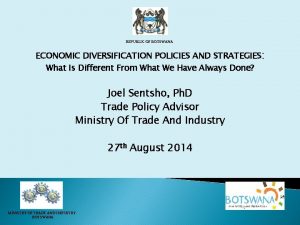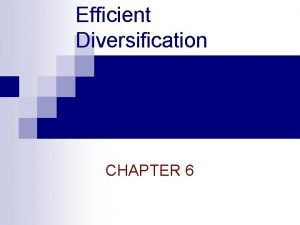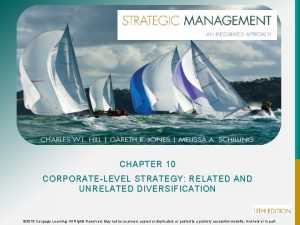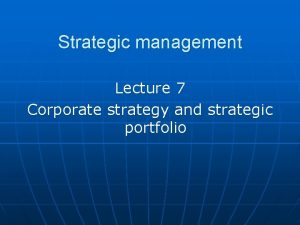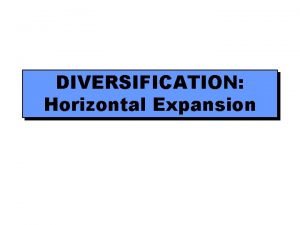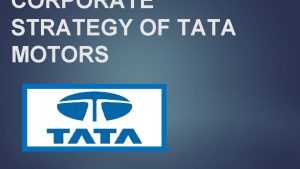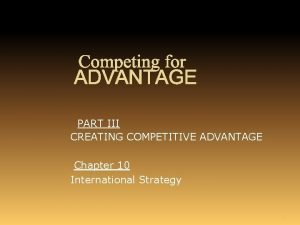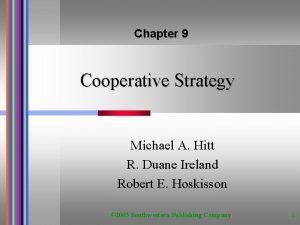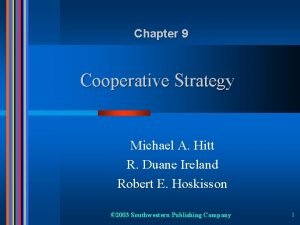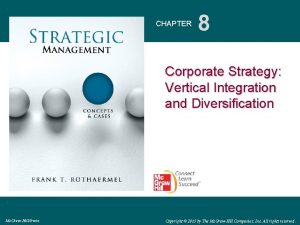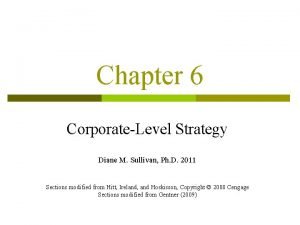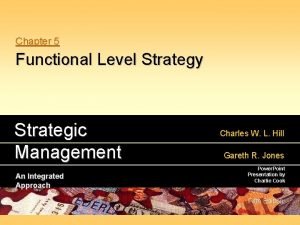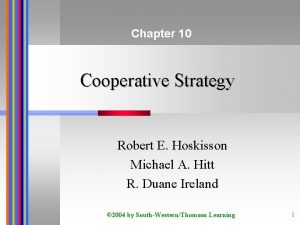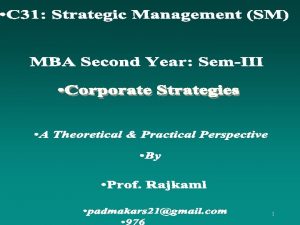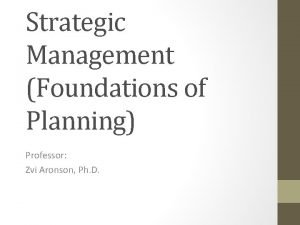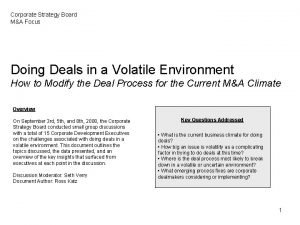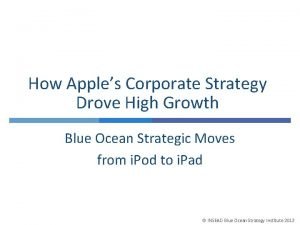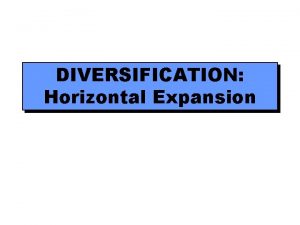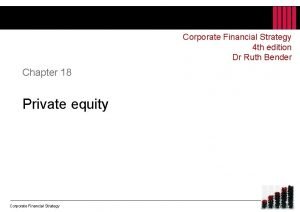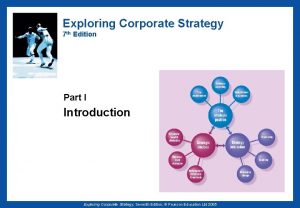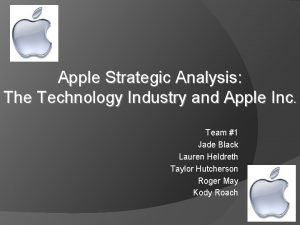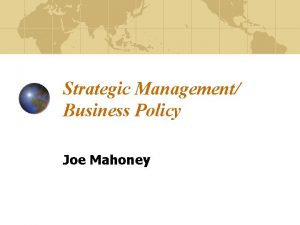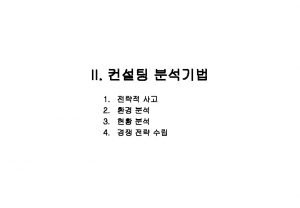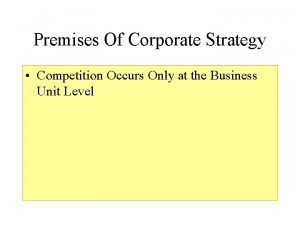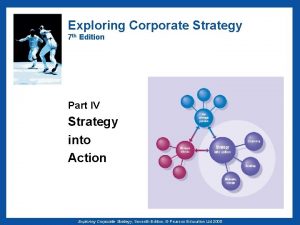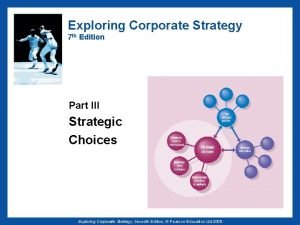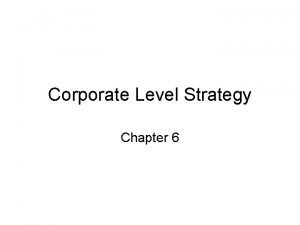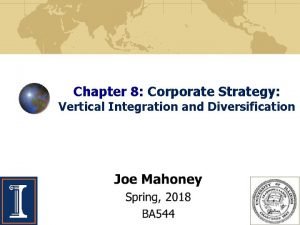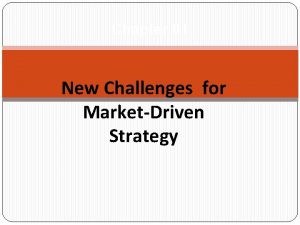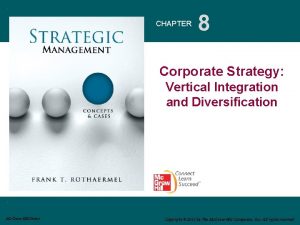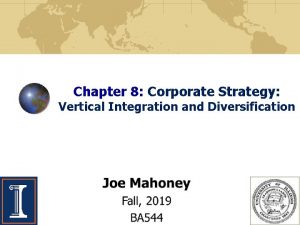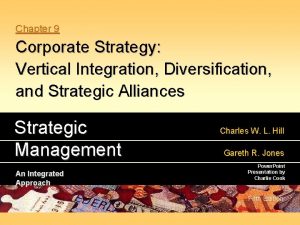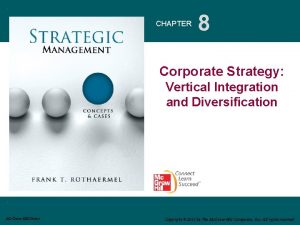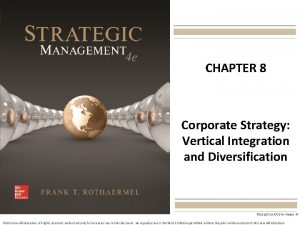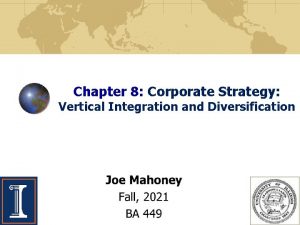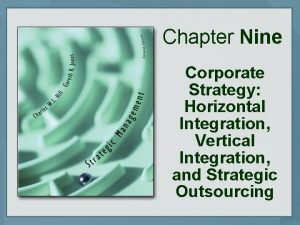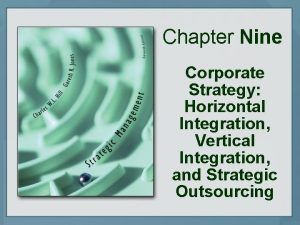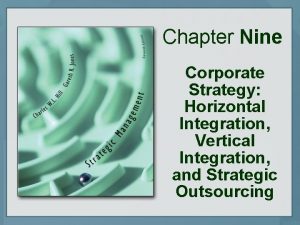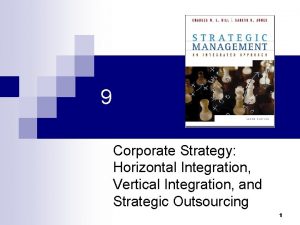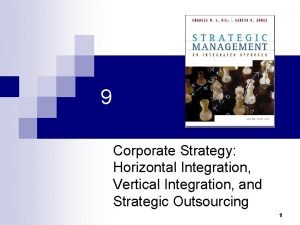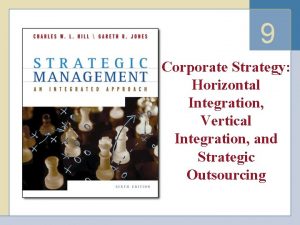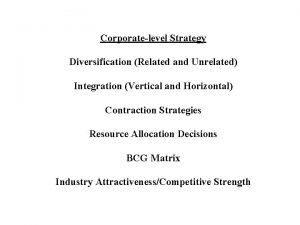CHAPTER 8 Corporate Strategy Vertical Integration and Diversification






















































- Slides: 54

CHAPTER 8 Corporate Strategy: Vertical Integration and Diversification Mc. Graw-Hill/Irwin Copyright © 2013 by The Mc. Graw-Hill Companies, Inc. All rights reserved.

Part 2 Strategy Formulation Christine 8 -2

Refocusing GE: A Future of Clean-Tech Chapter. Case 8 and Health Care? • Jeffrey Immelt appointed CEO of GE Sept. 7 th 2001 Ø Environmental Change (e. g. , 9/11 and Global Financial Crises) Ø GE’s stock price fell by 84% over 17 months Ø Loss of shareholder value of $378 billion Ø Lost AAA credit rating • Refocus on green economy and health care industries Ø Sold majority stake in NBC Universal to Comcast Ø Listed for sale its appliance unit Ø Two strategic initiatives put into play • ecomagination: solar energy, hybrid locomotives, fuel cells, efficient lighting…etc (this generates $25 billion annually in revenues) • healthymagination: increase quality and access to health care at a lower cost Christine 8 -3

Refocusing GE: A Future of Clean-Tech Chapter. Case 8 and Health Care? GE’s Changing Product Scope Christine Source: Author’s depiction of data in GE annual reports. 8 -4

Refocusing GE: A Future of Clean-Tech Chapter. Case 8 and Health Care? GE’s Changing Geographic Scope Christine Source: Author’s depiction of data in GE annual reports. 8 -5

What Is Corporate Strategy? • Corporate strategy Ø Quest for competitive advantage when competing in multiple industries v Ex: Jeffrey Immelt’s initiative in clean-tech and health care industries • Corporate strategy concerns the scope of the firm Ø Industry value chain Ø Products and services Ø Geography Christine 8 -6

What Is Corporate Strategy? (cont'd) • Three dimensions that determine the boundaries of the firm. . . Ø vertical integration - the stages of the industry value chain Ø horizontal integration and diversification – the range of products and services the firm should offer Ø global strategy - where in the world to compete tal n e ic m da ateg n fu str e th evel s. e ar te-l ion e es pora ecis h d T or c Christine 8 -7

EXHIBIT 8. 1 Three Dimensions of Corporate Strategy Scope of the firm determines boundaries along these 3 dimensions. Christine 8 -8

What Is Corporate Strategy? (cont'd) • Economies of scale Ø The average per-unit cost decreases as its output increases (the larger the market share, the lower the costs) v Ex: Anheuser-Busch Inbev largest global brewer • Economies of scope Ø Savings that come from producing two or more outputs or providing different services at less cost v Ex: Amazon range of products & services • Transaction cost Ø The cost associated with economic exchange v Christine "Make or buy" decision 8 -9

Transaction Cost Economics and Scope of the Firm • Transaction cost economics Ø Explains and predicts the scope of the firm Ø Scope v Gain & sustain competitive advantage v Formulating corporate strategy Ø In-house vs external market Ø Institutional arrangements SAV 8 -12

Transaction Cost Economics and Scope of the Firm • Transaction costs Ø Costs associated with economic exchanges v Firm OR markets v Ex: negotiating and enforcing contracts • Administrative costs Ø Organizing an exchange within a hierarchy v Recruiting & training v Paying salaries and benefits v Providing supplies SAV 11

Firms vs. Markets: Make or Buy • In-house (make)? Or externally (to buy)? • If Cin-house < Cmarket, then the firm should vertically integrate Ø Own input production or distribution outputs Ø Ex: Microsoft hires programmers Ø Both distinct advantages and disadvantages SAV 8 -13

EXHIBIT 8. 2 Organizing Economic Activity: Firm vs. Markets SAV 8 -14

Firms vs. Markets: Make or Buy? • Disadvantage of “make” in-house Ø Principal – agent problem v owner = principal, manager = agent Ø Personal interests • Disadvantage of “buy” from markets Ø Search cost Ø Opportunism Ø Incomplete contracting Ø Enforce legal contracts SAV 8 -15

Firms vs. Markets: Make or Buy? • Information asymmetries Ø Uneven level of knowledge v Akerlof – “Lemons problem” for used cars SAV 15

Alternatives of the Make or Buy Continuum • Short-term contacts Ø Competitive bidding process Ø < One-year term Ø Lower prices cost advantages • Strategic alliances Ø Facilitate investment without administrative costs Long-term contacts – Licensing & franchising v Joint ventures – Hulu v Equity alliances – Toyota & Orocobre v SAV 8 -16

STRATEGY HIGHLIGHT 8. 1 Toyota Locks Up Lithium for Car Batteries • World demand for lithium-ion batteries for cars ØGrow from $278 million in ‘ 09 to $25 billion in 2014 • Toyota wants to secure long-term supply of lithium to power its hybrid fleet • Orocobre holds exploration rights to a large salt-lake area ØUpfront investment to extract of lithium is very high • Should Orocobre make the investment to supply Toyota? ØTo encourage investment, Toyota took an equity position China Rare Earth Video SAV 1– 18 8 -18

Alternatives of the Make or Buy Continuum • Parent – subsidiary relationship Ø Most integrated alternative Ø Parent has command control v Ex: GM owns Opel and Vauxhall in Europe SAV 18

Vertical Integration along the Industry Value Chain • In what stages of the industry value chain should the firm participate? • Vertical integration Ø Ownership of its inputs, production, & outputs in the value chain • Horizontal value chain v Transform inputs into outputs, with activities ranging from basic R&D to customer service. CECILIA 8 -19

Vertical Integration along the Industry Value Chain • Vertical value chain (Industry) Ø Industry-level integration run from upstream to downstream v Examples: cell phone industry value chain • Many different industries and firms • Horizontal value chain (Internal, firm level) v Run Horizontally CECILIA 8 -20

EXHIBIT 8. 4 Backward and Forward Vertical Integration along an Industry Value Chain CECILIA 8 -21

Example: of Vertical Integration is “Cell phone” Stage 1: Raw Materials Stage 2: Intermediate goods Components Chemicals, ceramics, metals, oil, and so on. -Du. Pont (U. S. ), Exxon. Mobil (U. S. ), others. Integrated circuits, displays, touch screens, cameras, and batteries. -Jabil Circuit (U. S. ), Intel (U. S. ), others. Stage 3: Manufacturing Final Assembly Flextronics (Singapore) or Foxconn (China), others. Stage 4: Marketing Sales Stage 5: Telecommunications companies like Ericsson (Sweden), Motorola (U. S. ), Nokia (Finland), others. To get wireless data and voice service. CECILIA

Types of Vertical Integration • Full vertical integration Ø Ex: Weyerhaeuser • Owns forests, mills, and distribution to retailers The company's operations are divided into three major business segments: 1 - Timberlands — Growing and harvesting trees in renewable cycles. 2 - Wood Products — Manufacturing and distribution of building materials for homes and other structures. 3 - Cellulose Fiber — Research and development, manufacturing and distribution of pulp products. CECILIA 8 -23

Types of Vertical Integration • Backward vertical integration -Moving ownership of activities upstream to the originating (inputs) point of the value chain. • Forward vertical integration ØBy moving downstream into sales and increasing its branding activities. ØMoving ownership of activities closer to the end (customer) point of the value chain. CECILIA 8 -24

Types of Vertical Integration • Not all industry value chain stages are equally profitable Ø Zara – Vertically Disintegrated— *Primarily designs in-house & partners for speedy new *P fashions delivered to stores CECILIA 8 -25

EXHIBIT 8. 5 HTC’s Backward and Forward Integration along the Industry Value Chain in the Smartphone Industry CECILIA 8 -26

Benefits of Vertical Integration • Specialized assets Ø Assets that have significantly more value in their intended use than in their next best use • Types of specialized assets Ø Site specificity v Co-located such as mining equipment Ø Physical asset specificity v Bottling machinery – different shapes, unique molds Ø Human asset specificity v Christine Mastering procedures of a particular organization – not meant to be transferred elsewhere 8 -27

Risks of Vertical Integration • Increasing costs Ø Internal suppliers lose incentives to compete – always a buyer for their products • Reducing quality Ø Single captured customer can slow experience effects – external suppliers gain higher learning to develop quality products • Reducing flexibility Ø Slow to respond to changes in technology or demand – steel industry went bankrupt • Increasing the potential for legal repercussions Ø FTC carefully reviewed Pepsi plans to buy bottlers – vertical integration needs to be carefully considered Christine 8 -28

Alternatives to Vertical Integration • Taper integration orchestrates value activities Ø Backward integrated but also relies on outside market firms for supplies OR Ø Forward integrated but also relies on outside market firms for some of its distribution • Strategic outsourcing Ø Moving one or more internal value chain activities outside the firm's boundaries v v Christine Ex: EDS and People. Soft provide HR services to many firms that choose to outsource it Another example – support staff in schools 8 -29

EXHIBIT 8. 6 Taper Integration along the Industry Value Chain Outside suppliers could also be off-shored when they are not located in the home country Christine 8 -30

Corporate Diversification: Expanding Beyond a Single Market • Degrees of diversification Ø Range of products and services a firm should offer v Ex: Pepsi. Co also owns Lay's & Quaker Oats; Coca Cola only specializes in beverages • Diversification strategies: Ø Product diversification v Active in several different product categories Ø Geographic diversification v Active in several different countries Ø Product – market diversification v Christine Active in a range of both product and countries 8 -31

Types of Corporate Diversification • Single business v Google – 95% or more from one business • Dominant business v Microsoft – 70 – 95% from single business, also XBox • Related diversification Ø Related constrained v Exxon. Mobil – trying to move into another area Ø Related linked v Disney – active in a wide array of business activities • Unrelated diversification v Christine GE – less than 70% comes from a single business; they are all over the place with jet engines, household appliances, TV shows, etc 8 -32

EXHIBIT 8. 7 Different Types of Diversification Christine 8 -33

Leveraging Core Competencies for Corporate Diversification • Core competencies Ø Unique skills and strengths Ø Increase perceived value/lower production costs • Examples: Walmart – global supply chain v Apple - Integration and user experience v Infosys – low-cost global delivery system v • The core competence – market matrix Ø Guidance to diversification strategies v Leading to growth SAV 8 -37

EXHIBIT 8. 8 The Core Competence – Market Matrix Pepsi - Gatorade Bo. A - NCNB Salesforce. com Bo. A - Merrill Lynch SAV 8 -38

Corporate Diversification • Diversification discount Ø Stock price lowers • Diversification premium Ø Stock price is greater SAV 8 -39

Corporate Diversification (cont'd) • How does diversification enhance performance? Ø Economies of scale lower the cost Ø Economies of scope increase the value Ø Reduce cost and increase value simultaneously SAV 8 -41

EXHIBIT 8. 10 Vertical Integration and Diversification: Sources of Value Creation and Costs SAV 8 -42

Corporate Diversification (cont'd) • Restructuring Ø Reorganizing and divesting business units Ø Refocus and leverage core competencies • Boston Consulting Group growth-share matrix Ø Dogs v Low-performing Ø Cash cows v Low growth/considerable market share Ø Stars v High market share/fast growing market Ø Question marks v Unclear transformation SAV 8 -43

EXHIBIT 8. 11 BCG Matrix SAV 8 -44

Corporate Diversification (cont'd) • Internal capital markets Ø Value creation in diversification strategy Ø Efficient allocating of capital • Coordination cost Ø A function of number, size, and types of businesses linked to one another • Influence cost Ø Political maneuvering by managers to influence capital and resource allocation • Bandwagon effects Ø Firms copying moves of industry rivals SAV 8 -45

Corporate Strategy: Combining Vertical Integration and Diversification • Firms’ corporate strategy Ø Level of integration on value chain AND Ø Level of diversification Ex: Oracle earned $23 B in 2009 v Enterprise software is core competency – Backward integration – Sun Microsystems – Forward integration – People. Soft v Diversification at Oracle: – Related – IP management bought Sophoi – Unrelated – ID theft bought Bharosa v SAV 8 -46

EXHIBIT 8. 12 Oracle Corporate Strategy: Combining Vertical Integration and Diversification SAV 8 -47

Take-Away Concepts - Review LO 8 -1 Define corporate-level strategy, and describe three dimensions along which it is assessed. üWhile business strategy addresses “how to compete, ” corporate strategy addresses “where to compete”. üCorporate strategy concerns the scope of the firm along three dimensions: (1)vertical integration (along the industry value chain); (2)horizontal integration (diversification); and (3)geographic scope (global strategy). CECILIA

Take-Away Concepts - Review LO 8 -2 Describe and evaluate different options firms have to organize economic activity. ü Transaction cost economics help managers decide what activities to do in-house (“make”) versus what services and products to obtain from the external market (“buy”). ü When the costs to pursue an activity in-house are less than the costs of transacting in the market (Cin-house< Cmarket), then the firm should vertically integrate. ü Moving from less integrated to more fully integrated forms of transacting, alternatives include: *short-term contracts, *strategic alliances (including long-term contracts, equity alliances, and joint ventures), and *parent–subsidiary relationships. CECILIA

Take-Away Concepts - Review LO 8 -3 Describe two types of vertical integration along the industry value chain: backward and forward vertical integration. ü Industry value chains (vertical value chains) depict the transformation of raw materials into finished goods and services. Each stage typically represents a distinct industry in which a number of different firms are competing. ü Backward vertical integration involves moving ownership of activities upstream nearer to the originating (inputs) point of the industry value chain. ü Forward vertical integration involves moving ownership of activities closer to the end (customer) point of the value chain. CECILIA

Take-Away Concepts - Review LO 8 -4 Identify and evaluate benefits and risks of vertical integration. ü Benefits of vertical integration include: *securing critical supplies, *lowering costs, *improving quality, *facilitating scheduling and planning, and *facilitating investments in specialized assets. ü Risks of vertical integration include: *increasing costs, *reducing quality, *reducing flexibility, and *increasing the potential for legal repercussions. CECILIA

Take-Away Concepts - Review LO 8 -4 Identify and evaluate benefits and risks of vertical integration. ü Vertical integration contributes to competitive advantage if the incremental value created is greater than the incremental costs of the specific corporate -level strategy. CECILIA

Take-Away Concepts - Review LO 8 -6 Diversification An increase in the variety of products or markets in which to compete. There are various general diversification strategies: *Product Diversification Strategy. *Geographic Diversification Strategy. *Product-Market Diversification Strategy. CECILIA

Take-Away Concepts - Review LO 8 -8 Explain when a diversification strategy creates a competitive advantage, and when it does not. ü Both low levels and high levels of diversification are generally associated with lower overall performance, while moderate levels of diversification are associated with higher firm performance. CECILIA

MINI CASE 8 -Core Competencies: From Circuit City to Car. Max • Early 1990 s, executives look for new ways to utilize core competencies in other markets • Leverage retail competency and improve customer buying experience • Launch Car. Max in 1993 Ø Buy Trade-Ins at Blue Book value, even if you don’t buy Ø Buying used car=root canal experience Ø First store right by Circuit City Headquarters Ø 125 point inspection and detailing Ø No haggle pricing, 5 day returns Ø Thousands of cars for sale at any time Ø 100 Best companies to work for Ø 100 locations, employ 13, 500 people, sell 350, 000 cars, revenue $8 billion 7– 51

MINI CASE 8 -Core Competencies: From Circuit City to Car. Max 1. Do you judge Car. Max to be successful? Why or why not? 2. What type of diversification strategy is Circuit City’s Car. Max business venture? 3. Looking at core competence-market matrix in Exhibit 8. 8, does circuit City’s Car. Max diversification fall neatly into one of the four quadrants? Why or why not? 7– 52

MINI CASE 8 -Core Competencies: From Circuit City to Car. Max 4. Was Car. Max a good strategic move for Circuit City? Why or why not? 5. In 2002, Circuit City sold off Car. Max, which trades on the NYSE under KMX. Was this a good decision by Circuit City’s top management team? Why or why not? 7– 53

Questions? 7– 54
 Business strategy vs corporate strategy
Business strategy vs corporate strategy What is vertically integrated company
What is vertically integrated company Strategy formulation corporate strategy
Strategy formulation corporate strategy Vertical integration
Vertical integration Samsung unrelated diversification strategy
Samsung unrelated diversification strategy Related and unrelated diversification
Related and unrelated diversification Economic diversification drive strategy botswana
Economic diversification drive strategy botswana Volkswagen diversification strategy
Volkswagen diversification strategy Dominant business diversification strategy
Dominant business diversification strategy Goal of corporate finance
Goal of corporate finance Efficient diversification
Efficient diversification Forward integration and backward integration
Forward integration and backward integration Integration
Integration Disadvantages of horizontal integration
Disadvantages of horizontal integration Vertical and horizontal integration worksheet
Vertical and horizontal integration worksheet Related and unrelated diversification
Related and unrelated diversification Intensive integrative and diversification growth strategies
Intensive integrative and diversification growth strategies Unrelated diversification companies
Unrelated diversification companies Intensive integrative and diversification growth strategies
Intensive integrative and diversification growth strategies Types of corporate level strategy
Types of corporate level strategy What is corporate strategy in strategic management
What is corporate strategy in strategic management Ebusiness strategy
Ebusiness strategy Three dimensions of corporate strategy
Three dimensions of corporate strategy Strategic hrm tools
Strategic hrm tools Horizontal diversification
Horizontal diversification Tata motors founded
Tata motors founded Corporate strategy triangle
Corporate strategy triangle A multidomestic corporate-level strategy is one in which:
A multidomestic corporate-level strategy is one in which: Corporate level cooperative strategy
Corporate level cooperative strategy Corporate level cooperative strategy
Corporate level cooperative strategy Corporate strategy
Corporate strategy Diversification types
Diversification types Business level strategy
Business level strategy Business-level strategy
Business-level strategy Corporate level cooperative strategy
Corporate level cooperative strategy Formulating corporate level strategy
Formulating corporate level strategy Types of corporate level strategy
Types of corporate level strategy Swot analysis in education example
Swot analysis in education example Corporate strategy board
Corporate strategy board Apple corporate strategy
Apple corporate strategy Three dimensions of corporate strategy
Three dimensions of corporate strategy Corporate financial strategy
Corporate financial strategy Nintendo bcg matrix
Nintendo bcg matrix Exploring corporate strategy 7th edition
Exploring corporate strategy 7th edition Apple industry overview
Apple industry overview Strategic planning process
Strategic planning process Role of corporate governance in strategy formulation
Role of corporate governance in strategy formulation A transnational corporate-level strategy seeks to achieve
A transnational corporate-level strategy seeks to achieve Elements of strategic thinking
Elements of strategic thinking Multipoint competition occurs when
Multipoint competition occurs when Exploring corporate strategy 7th edition
Exploring corporate strategy 7th edition Exploring corporate strategy 7th edition
Exploring corporate strategy 7th edition Value neutral diversification
Value neutral diversification Corporate strategy
Corporate strategy Market driven strategies
Market driven strategies

